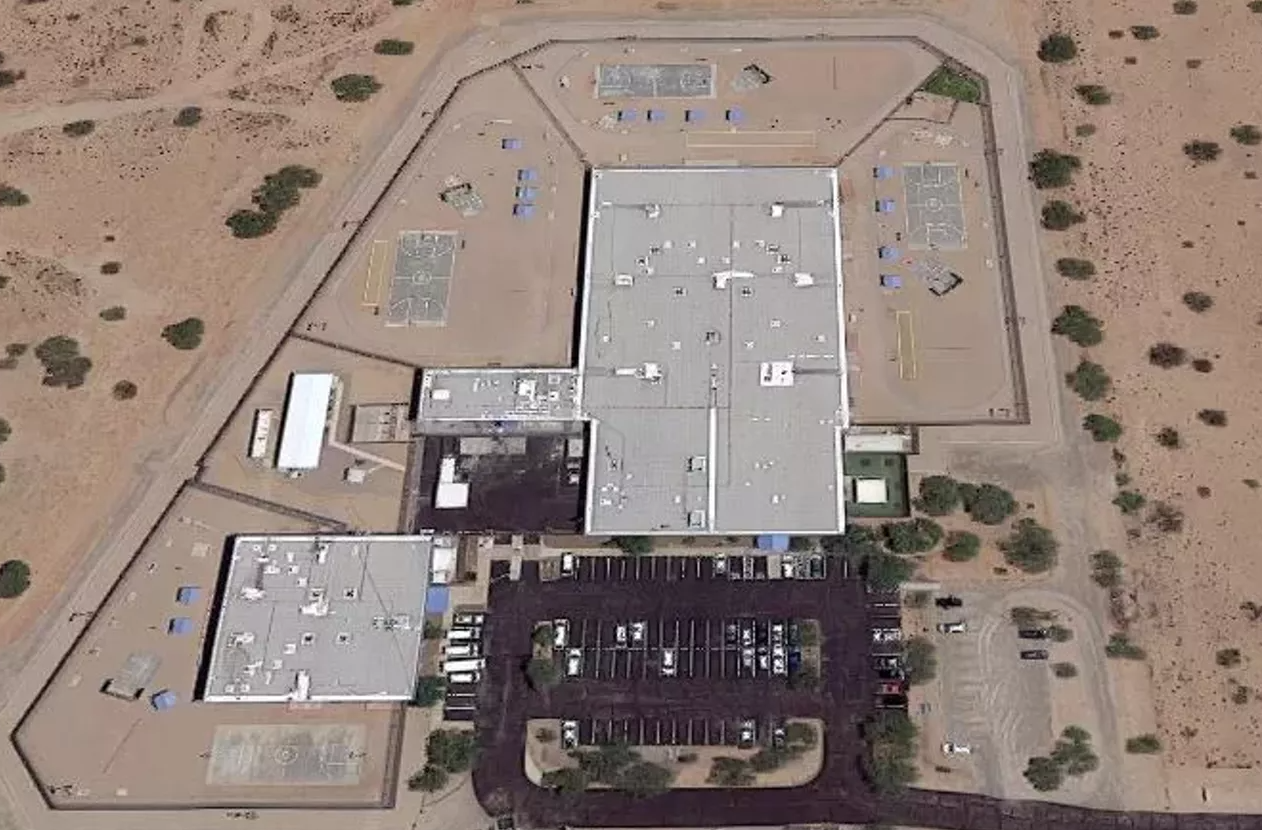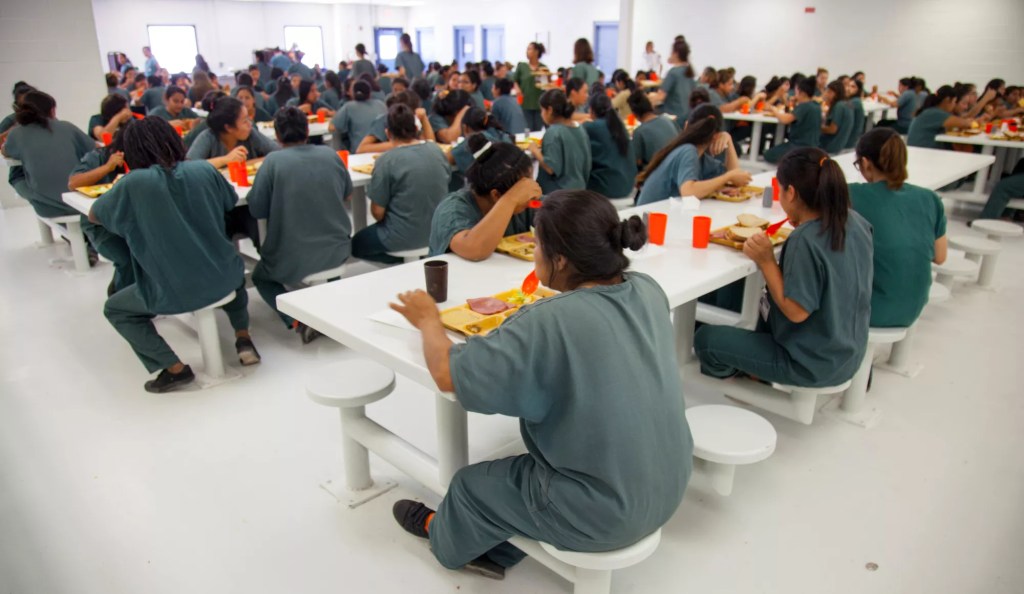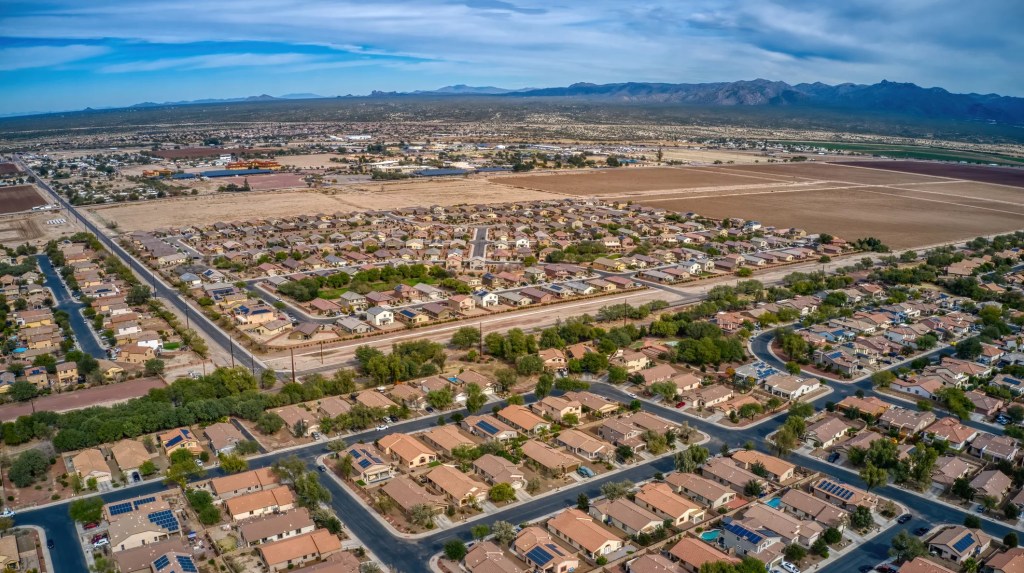

Audio By Carbonatix
On a quiet patch of land surrounded by miles of cotton fields, and not far from the blinking lights of Marana’s regional airport, the turn-off to a vacant prison building is marked by an empty frame of a sign and a dead cactus, reduced to its ribs but still reaching to the sky. Outside the facility itself, cracked asphalt leads to low-lying gray buildings, some topped with barbed wire. The basketball court stands empty and lit.
The facility could soon be the site of an immigration detention center after private prison operator Management and Training Corp. (MTC) bought it from the state this summer, despite what appears to be growing community opposition and no opportunity for a vote from local officials.
A packed community forum turned impromptu organizing meeting, held Oct. 23, offered a first look for many into the reality of the detention center, what community members want to know about the project moving ahead, and how some of them may try to stop it.
MTC did not respond to a request for comment.
This year, make your gift count –
Invest in local news that matters.
Our work is funded by readers like you who make voluntary gifts because they value our work and want to see it continue. Make a contribution today to help us reach our $30,000 goal!
The meeting was convened by District 3 Supervisor Jen Allen, with panelists from the ACLU of Arizona, Just Communities Arizona and the Florence Project. Attendees took green question cards, discussed with others at their table, and formed a line to ask the panelists questions. They held Abolish ICE and Defund ICE posters, and often jeered or booed at the mere mention of U.S. Immigration and Customs Enforcement, or ICE, moving into town.
Allen noted the potential “ripple effects” of opening a detention center, including the fear of local community members. “It affects our families, it affects our neighbors, our schools. It affects businesses. It affects every facet of our community,” said Allen. “Getting engaged now is the right time to be doing it.”
As Trump’s immigration crackdown continues to surge in many parts of the country, recent data point to an unprecedented number of people locked up in immigration detention centers. As of Sept. 21, about 60,000 people were detained, according to a data research center at Syracuse University. A 2022 study showed that “immigrants in counties with more detention space are significantly more likely to be arrested and detained by ICE.” That fear seems to have been one of the main reasons so many people turned out against the possible facility in Marana.
Among the 300-plus people who showed up Thursday night was Marana resident Evy McDonald.
She told Arizona Luminaria she wasn’t sure what to expect from the forum. But when she walked in to see those hundreds of people, “I felt like I walked into a sea of hope,” she said.
McDonald said she’s been an activist and protester for half a century, and that the younger generations taking up social justice now have a lot to learn from their elders. “We were the young adults who burned draft cards, who burned bras,” she said. “If the center opens, there’s a lot we can still do to disrupt things. You have to be willing to put your privilege and your life on the line.”
She was one of many people that night who were making a call to action.
Here’s what people asked at the forum, and the key points of information to catch up on the status of a possible immigration detention center in southern Arizona.

Gage Skidmore/Flickr/CC BY-SA 2.0
How did we get here?
A key question attendees asked was how we got here, and who approved a plan to turn the shuttered prison into an immigration detention facility.
This summer, Congress approved $45 billion for new detention centers, part of an increase in spending for immigration enforcement that experts say would significantly grow America’s immigration enforcement apparatus. That would be a 256% annual budget increase to ICE’s current detention budget, according to the American Immigration Council.
MTC runs five immigration detention centers across the country, and one in Australia; the Marana facility would be the sixth in the U.S.
The Arizona Department of Administration, a state agency that acts as the administrative hub for state government, sold the building back to MTC in July for $15 million. MTC had previously operated a minimum security prison in the building until 2023, when the state ended the contract because the facility was operating at less than half capacity, according to a news release from Gov. Katie Hobbs’ office.
“MTC operates the Arizona State Prison — Marana, a minimum security prison with capacity for 500 male inmates. Over the last several years however, the facility has averaged an inmate population of 225,” the release said. “Despite the reduced population, ADCRR is required by contract to pay for nearly 475 beds. By ending the contract, the State will save an estimated $5 million in FY24, and nearly $10 million in FY25.”
The capacity of the Marana detention center is 500 people. In 2017, when the population of the private prison was near capacity at 487, the prison employed 119 people, according to a state audit of the facility.
As the state owned the facility, and it was already zoned for a prison, there was no local approval required for the sale to move ahead, said speakers on Thursday.
“I just want to point out that the state of Arizona did sell this to MTC. They didn’t have to,” said Noah Schramm, the Immigrants’ Rights and Border Policy Strategist at the ACLU of Arizona.
When the facility may open is uncertain. Liz Casey, of the Florence Project, said she’s been looking for job postings online as one way to see if they’re hoping to begin operations soon.
In an August statement to Arizona Luminaria, the Town of Marana said it had not been involved in the procurement process, and therefore did not track local reactions or concerns.
“As a municipality, we have always been in favor of a facility use that would generate local employment and create opportunities for collaboration on essential public services, such as road and street cleaning that could be performed by inmates,” the statement said.
Only one member of the Marana town council, Patrick Cavanaugh, attended Thursday’s meeting. He said it was frustrating to watch a detention center moving ahead without any clear levers to step in. “We’re not paying their bills, so there’s really nothing we can do,” he said. “In everything we’re seeing across this country, they’re not giving any due process. These are our neighbors, you know? That’s the problem here.”

Charles Reed/Immigration and Customs Enforcement
What is the experience of people detained in private prisons, or other MTC facilities?
Conditions in immigration detention are stark, punishing and sometimes deadly, said Thursday’s panel.
Casey, a social worker with the Florence Project who helps document conditions in Arizona detention centers said that water and power outages, issues with access to hygiene, and medical neglect are common in immigration detention centers. Two people have died in Arizona immigration detention this year — one in Eloy and one in Florence.
Schramm, of the ACLU, echoed the critiques. “ICE detention centers across the country have consistently been places where people’s most basic and fundamental rights and dignity are violated,” he said.
“It is worth remembering that the people who are detained in these places often have not had a judge consider their case, have not had their day in court, have not been convicted of a crime,” Schramm said. “This is civil detention. It’s not supposed to be punitive, and yet, for years, we have heard so many stories of physical and verbal abuse by detention staff, of people being subjected to solitary confinement for the most minor infractions.”
Isaacson said that the push to cut costs was especially strong for private prison providers who made a profit by using less money than they were paid to run the facility.
“They’re competing for contracts with the government. That’s a competitive process,” she said. “They’ve got to come in as the lowest bidder, and then they’re going to make a profit on top of that. How do they do that? They do that by cutting corners.”
Watchdog groups have raised concerns about conditions at most of MTC’s immigration detention facilities
- The MTC-owned and operated Imperial Regional Detention Facility in California did not have a nebulizer to help a detained person who eventually died of bronchopneumonia; at the time, the company had a policy to reorder medical supplies every two months regardless of whether they ran out earlier, according to a 2018 Human Rights Watch report.
- At Otero County Processing Center a report from immigrant rights group Freedom for Immigrants found over 200 complaints of abuse between 2015 and 2018 that included inadequate food and medical attention, limited access to hygiene supplies and harassment by guards.
- A lack of access to clean water, medication, along with freezing temperatures and lack of access to legal services were identified by Amnesty International from an April 2025 visit to the Bluebonnet Detention Center in Texas.
- The El Valle Detention Facility in Texas was formerly the Willacy Detention Center, where advocates identified poor medical care, sexual abuse and overuse of solitary confinement.
- IAH in Texas has had at least one detained person die following their detention; the ACLU of Texas has called for the facility to be shut down due to inadequate medical care and extensive use of solitary confinement.
A member of the audience also spoke about their decade of experience as a former correctional officer. Detainees faced abuse and violence, but so did staff, she said. “It is not good for anyone.”
Have immigration detention centers been stopped before?
While detention centers have been opened around the country, community organizers have stopped or slowed down efforts to open new facilities.
In Leavenworth, Kansas, a conservative community in an area full of federal and state prisons, some local officials and residents have used the permitting process as a public way to register their concern about a detention center in the area. Most recently, city leaders filed two lawsuits against CoreCivic, the company proposing to run the facility.
In 2011 in Florida’s Southwest Ranches, CoreCivic (formerly CCA) wanted to build a detention facility with a capacity of 1,500 people. But as residents in the neighboring town of Pembroke Pines were worried about dipping property values and were generally against the project, the city of Pembroke decided to cancel a contract supplying sewage, water, and fire-rescue services to Southwest Ranches. That was enough of a headache to scare away CoreCivic, which pulled out of plans to build in Southwest Ranches.
SouthWest Ranches sued Pembroke for damages — lost revenue. After a decade-long fight, they lost in court, and Southwest Ranches was billed with $2 million in legal fees.
Allen also said that localities have considered revoking permits or opening up a conversation about zoning again. She also suggested talking to the farmers around the heavily agricultural surrounding area about how this would impact them.

Jacob Boomsma/Getty Images
How will a new immigration detention center impact enforcement in communities?
Another Marana resident, Clement DeLarge, asked at the forum: “Is ICE going to be hanging out at churches and schools and things like that?”
Cities across the country have seen an uptick in immigration enforcement with the Trump administration’s mandate to increase deportation numbers.
In some communities, including most recently an aggressive blitz in Chicago, that has meant hostile stops by masked agents that leave people out of communication for days. More than 170 U.S. citizens have been held by immigration agents in recent months, ProPublica found.
Having an immigration detention facility in the region with capacity for at least 500 people would almost certainly lead to increased enforcement in Southern Arizona, the panelists said.
Detention center contracts sometimes include a minimum number of people that have to be detained, said Casey. “They will fill it,” she said. “If that means filling it with people from the neighborhood, that potentially could happen.”
Mo Goldman, an immigration attorney who has practiced law in Arizona since 2000, said he had witnessed “so much pain and hardship” in detention centers. He also reminded the crowd that the funding for the Marana private detention center would be provided by public dollars. “It’s not money that just comes out of nowhere,” he said.
Isaacson also noted that immigration detention centers, even as companies promised jobs, actually depressed property values and drained resources like water and electricity. “When is the last time y’all went shopping in Florence? Anybody looking at houses in Eloy on Zillow?” she asked. “You’re popping down a small city in the middle of your city, and again, you’re paying for that.”
The panelists also warned about the detention-related safeguards that have been eroded since the Trump administration took office, which will make it more difficult to fight against abuses. The administration shuttered the Department of Homeland Security’s Office for Civil Rights and Civil Liberties, as well as the independent ombudsman office that monitored immigration detention..
Casey said that wrongful death lawsuits were one tool that remained, along with efforts by elected officials to attempt to get access to detention facilities as one means of oversight, even if those visits were no longer possible to conduct unannounced. Rep. Yassamin Ansari recently visited a detention center in Eloy to draw attention to what she says are abusive conditions faced by immigrants.
What’s next?
Multiple attendees called for Thursday’s meeting to be the first step in a campaign to block the possible immigration detention center.
Jeanne Lukasko said they wanted to see everyone in the same place next month to continue working together. “I’m seeing the energy here tonight. We’ve got to keep it going. We’ve got to come back next month.”
Schramm said public pressure was one of the strongest tools available to share opposition to the Marana prison becoming an immigration detention center. “As a private sale right now. I think the best thing, the most powerful thing, is to build clear public opposition,” he said. “Make it clear not only to MTC, but also to your local elected representatives, representatives in the House and the Senate, that this is intolerable, that this is a priority issue, that this is something that you will not stop bothering them about.”
William Joseph, a Marana resident, told Arizona Luminaria that he was “totally opposed” to the detention center. “I don’t trust ICE at all. They’re snatching people left and right.”
This article first appeared on AZ Luminaria and is republished here under a Creative Commons Attribution-NoDerivatives 4.0 International License.